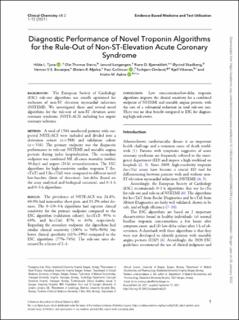| dc.contributor.author | Tjora, Hilde Lunde | |
| dc.contributor.author | Steiro, Ole-Thomas | |
| dc.contributor.author | Langørgen, Jørund | |
| dc.contributor.author | Bjørneklett, Rune Oskar | |
| dc.contributor.author | Skadberg, Øyvind | |
| dc.contributor.author | Bonarjee, Vernon V S | |
| dc.contributor.author | Mjelva, Øistein | |
| dc.contributor.author | Collinson, Paul | |
| dc.contributor.author | Omland, Torbjørn | |
| dc.contributor.author | Vikenes, Kjell | |
| dc.contributor.author | Aakre, Kristin Moberg | |
| dc.date.accessioned | 2022-02-21T14:23:42Z | |
| dc.date.available | 2022-02-21T14:23:42Z | |
| dc.date.created | 2022-01-25T17:16:50Z | |
| dc.date.issued | 2022 | |
| dc.identifier.issn | 0009-9147 | |
| dc.identifier.uri | https://hdl.handle.net/11250/2980593 | |
| dc.description.abstract | Background
The European Society of Cardiology (ESC) rule-out algorithms use cutoffs optimized for exclusion of non-ST elevation myocardial infarction (NSTEMI). We investigated these and several novel algorithms for the rule-out of non-ST elevation acute coronary syndrome (NSTE-ACS) including less urgent coronary ischemia.
Method
A total of 1504 unselected patients with suspected NSTE-ACS were included and divided into a derivation cohort (n = 988) and validation cohort (n = 516). The primary endpoint was the diagnostic performance to rule-out NSTEMI and unstable angina pectoris during index hospitalization. The secondary endpoint was combined MI, all-cause mortality (within 30 days) and urgent (24 h) revascularization. The ESC algorithms for high-sensitivity cardiac troponin T (hs-cTnT) and I (hs-cTnI) were compared to different novel low-baseline (limit of detection), low-delta (based on the assay analytical and biological variation), and 0–1-h and 0–3-h algorithms.
Results
The prevalence of NSTE-ACS was 24.8%, 60.0% had noncardiac chest pain, and 15.2% other diseases. The 0–1/0–3-h algorithms had superior clinical sensitivity for the primary endpoint compared to the ESC algorithm (validation cohort); hs-cTnT: 95% vs 63%, and hs-cTnI: 87% vs 64%, respectively. Regarding the secondary endpoint, the algorithms had similar clinical sensitivity (100% vs 94%–96%) but lower clinical specificity (41%–19%) compared to the ESC algorithms (77%–74%). The rule-out rates decreased by a factor of 2–4.
Conclusion
Low concentration/low-delta troponin algorithms improve the clinical sensitivity for a combined endpoint of NSTEMI and unstable angina pectoris, with the cost of a substantial reduction in total rule-out rate. There was no clear benefit compared to ESC for diagnosing high-risk events. | en_US |
| dc.language.iso | eng | en_US |
| dc.publisher | Oxford University Press | en_US |
| dc.rights | Navngivelse 4.0 Internasjonal | * |
| dc.rights.uri | http://creativecommons.org/licenses/by/4.0/deed.no | * |
| dc.title | Diagnostic Performance of Novel Troponin Algorithms for the Rule-Out of Non-ST-Elevation Acute Coronary Syndrome | en_US |
| dc.type | Journal article | en_US |
| dc.type | Peer reviewed | en_US |
| dc.description.version | publishedVersion | en_US |
| dc.rights.holder | Copyright American Association for Clinical Chemistry 2021 | en_US |
| cristin.ispublished | true | |
| cristin.fulltext | original | |
| cristin.qualitycode | 2 | |
| dc.identifier.doi | 10.1093/clinchem/hvab225 | |
| dc.identifier.cristin | 1989823 | |
| dc.source.journal | Clinical Chemistry | en_US |
| dc.source.pagenumber | 291–302 | en_US |
| dc.identifier.citation | Clinical Chemistry. 2022, 68 (2), 291–302. | en_US |
| dc.source.volume | 68 | en_US |
| dc.source.issue | 2 | en_US |

